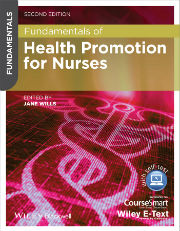
Fundamentals of Health Promotion for Nurses
Second Edition
Edited by Jane Wills

Short Answer Questions
Chapter 6: Alcohol
1. What are the terms used to describe levels of drinking?
-
The World Health Organization uses the following terms to describe drinking:
- Harmful
- Dependent
- Hazardous The NHS also uses these terms to describe risk categories:
- Lower-risk drinkers
- Increasing-risk drinkers
- Higher-risk drinkers
2. What is a unit of alcohol?
One alcohol unit is measured as 10 ml or 8 grams of ethyl alcohol. This equates to about a single measure of spirits or about half a pint of beer or less than a small glass of wine. A litre of 12% wine has 12 units and a 250 ml glass of 12% wine is a quarter of a litre, so is 3 units. A 500 ml can of 8% beer is 1/2 litre so has 4 units. A 330 ml bottle of 9% beer is a 1/3 litre so has 3 units.
3. What are the current recommended drinking levels?
Current guidance states that men should not exceed 3-4 units per day on a regular basis and women should not exceed 2-3 units per day on a regular basis.
4. Why is alcohol a public health priority?
- Your answer might include:
- Rising levels of liver disease
- The association of alcohol with public disorder
- The association with A&E admissionsThe association with A&E admissions
- Although only a minority of road traffic accident fatalities are linked to drink driving, it is implicated in 15% of cases
- Nearly half of all violent incidents are committed by people who have been drinking.
5. What is the AUDIT test?
AUDIT is the Alcohol Use Disorders Identification Test, a short questionnaire to ascertain drinking levels and hazardous drinking which is used in A&E departments, psychiatric services, homelessness services, antenatal clinics, general hospital wards and criminal justice settings.
6. Name some key messages for reducing drinking harm.
- Tobacco control is the term used to describe efforts to control the availability and access to the substance. Some of the more recent aspects include:
- Sticking to recommended guidelines.
- Having days without alcohol.
- Alternating alcoholic drinks with ones containing no alcohol.
- Trying not to drink on an empty stomach.
- Avoid buying in rounds and drinking slowly.
- Keeping a daily drinks diary to monitor consumption.
- Diluting drinks.
- Avoiding spirits.
7. What does SMART stand for in relation to "healthy conversations"?
SMART is an acronym for a process of setting effective goals and objectives: Specific, Measurable, Achievable, Realistic and in a Timeframe.
8. Understanding why people do or don't change is helpful in understanding how to motivate someone to change their health behaviour(s). Which one of these is the most common reason why people don't change?
- Lack of insight
- Not knowing how to
- Ambivalence
Often people will know the harms associated with their behaviour but they may feel ambivalent about change.